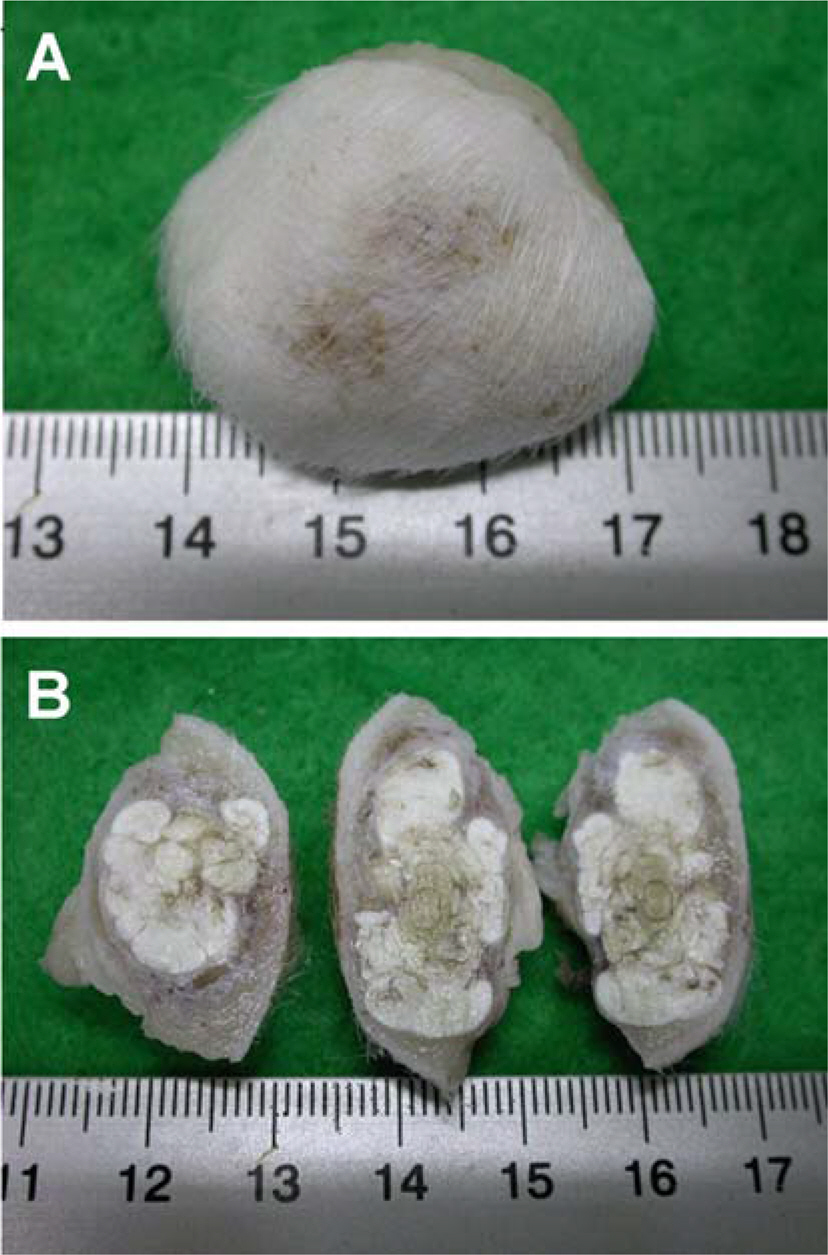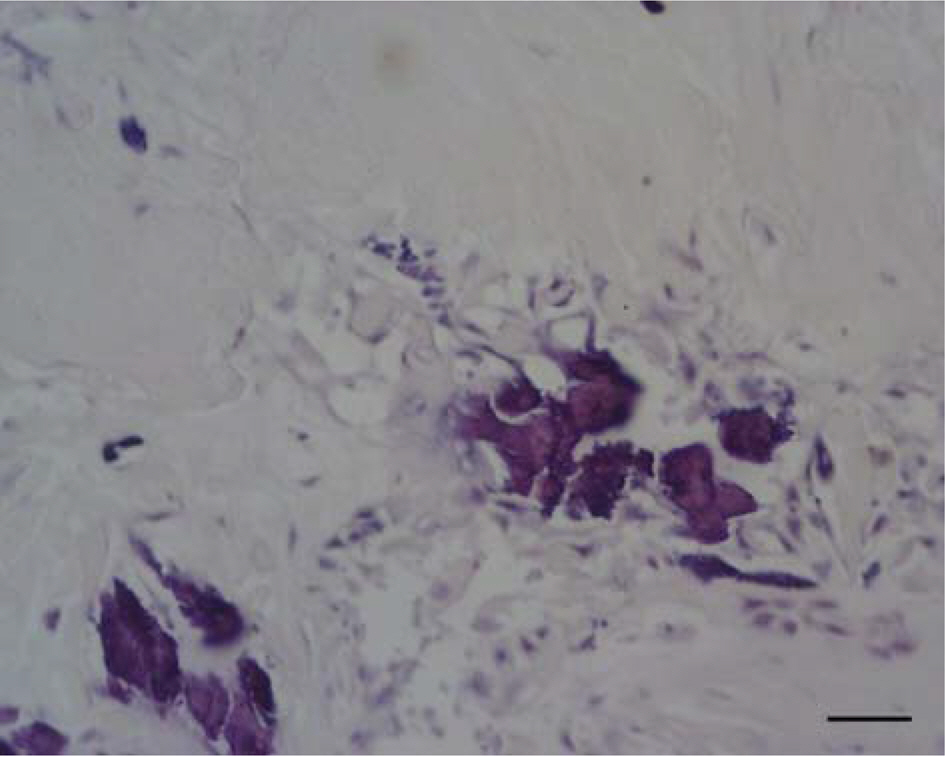Lab Anim Res.
2010 Mar;26(1):117-120. 10.5625/lar.2010.26.1.117.
Pilomatrixoma in a Maltese Dog
- Affiliations
-
- 1Department of Pet Management, Daegu Polytechnic College University, Daegu, Korea.
- 2College of Veterinary Medicine, Konkuk University, Seoul, Korea.
- 3College of Veterinary Medicine, Kyungpook National University, Daegu, Korea. jeongks@knu.ac.kr
- KMID: 1458949
- DOI: http://doi.org/10.5625/lar.2010.26.1.117
Abstract
- A 12-year-old female Maltese dog brought to a local veterinary clinic with two nodules in the subcutis of left shoulder. The nodules were grown gradually from 2 years ago. The nodules were removed surgically under anesthesia and examined histopathologically. They were 15x26 mm in diameter (oval form) and 12x15 mm in diameter (round form), respectively. Histopathologically, the lesions consisted of multilayered basaloid cells in the peripheral of the mass and ghost cells in the central region. Typical findings of these two nodules were gradually keratinized basaloid cell toward central area result in forming anuclear ghost cells. These microscopic features of cutaneous nodules were diagnosed as pilomatrixoma and the identified findings were similar to fully developed stage of human pilomatrixoma. This report may assist in the categorizing of canine pilomatrixoma using histopathological features.
Keyword
Figure
Reference
-
Danny W.S.., Wayne I.A.1991. Canine hair follicle neoplasms: a retrospective analysis of 80 cases (1986-1987). Veterinary Dermatology. 2:143–150.Du Vivier A.., McKee P.1993. Benign tumours of the skin. In Atlas of Clinical Dermatology (Du Bivier, A. ed.), pp.8.11-8.12, Gower Medical Publishing, London.Forbis R.., Helwig E.B.1961. Pilomatrixoma (calcifying epithelioma). Arch. Dermatol. 83:606–618.
ArticleGoldshmidt M.H.., Shofer F.S.1992. Skin Tumours of the Dog and Cat. 125–130. Butterworth-Heinemann, Oxford.Grabczynska S.A.., Budny P.., Calonjet E.., Ratnavel R.2002. Case 3: Multiple familial pilomatrixoma. Clin. Exp. Dermatol. 27:343–344.Gross T.L.., Ihrke P.J.., Walder E.J.1992. Veterinary Dermatopathology, pp. 365–367. Mosby Year Book, St. Louis.Hashimoto K.., Lever W.F.1999. Tumor of skin appendages. In Dermatology in General Medicine (Fitzpatrick, T.B. ed.), 5th ed., pp.890–914. McGraw-Hill, New York.Kaddu S.., Soyer H.P.., Hodl S.., Kerl H.1996. Morphological stages of pilomatricoma. Am. J. Dermatopathol. 18:333–8.
ArticleKaddu S.., Soyer H.P.., Wolf I.H.., Kerl H.1997. Proliferating pilomatricoma. A histopathologic simulator of matrical carcinoma. J. Cutan. Pathol. 24:228–234.
ArticleMacKie R.M.1998. Tumours of the skin appendages. In Textbook of Dermatology (Champion, R.H. ed.), 6th ed., pp.1685–1715. McGraw-Hill, New York.McKee P.1999. Essential Skin Pathology. p. 160. Mosby International Ltd;London:Moehlenbeck F.W.1973. Pilomatrixoma (calcifying epithelioma). A statistical study. Arch. dermatol. 108:532–534.
ArticleTheilen G.H.., Medewell B.R.1987. Veterinary Cancer Medicine. pp.257, Lea and Febiger, Philadelphia.Toma S.., Noli C.2005. Isotretinoin in the treatment of multiple benign pilomatrixomas in a mixed-breed dog. Veterinary Dermatology. 16:346–350.
ArticleWalsh J.S.., Fairley J.A.1999. Cutaneous mineralization and ossification. In Dermatology in General Medicine (Fitzpatrick, T.B. ed.), 5th ed., pp.1829–1835. McGraw-Hill, New York.Wang J.., Cobb C.J.., Martin S.E.., Venegas R.., Wu N.., Greaves T.S.2002. Pilomatrixoma: Clinicopathologic study of 51 cases with emphasis on cytologic features. Diagn. Cytopathol. 27:167–172.
Article
- Full Text Links
- Actions
-
Cited
- CITED
-
- Close
- Share
- Similar articles
-
- Mesenchymal chondrosarcoma in the maxillary gingiva of a Maltese dog: a case report
- Echocardiographic parameters and indices in 23 healthy Maltese dogs
- A Case of oculocutaneous albinism in a Maltese
- Familial mitral valve prolapse in a Maltese dog family
- Unruptured right sinus of Valsalva aneurysm in a Maltese dog: a case report




